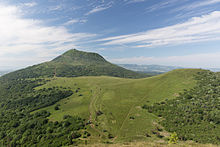Puy de Dôme (US: , French: [pɥi də dom] ; Auvergnat: Puèi Domat [ˈpœj duˈma(t)] or Puèi de Doma [ˈpœj də ˈdumɔ]) is a lava dome and one of the youngest volcanoes in the Chaîne des Puys region of Massif Central in central France. This chain of volcanoes including numerous cinder cones, lava domes and maars is far from the edge of any tectonic plate. Puy de Dôme was created by a Peléan eruption, some 10,700 years ago. Puy de Dôme is approximately 10 km (6 miles) from Clermont-Ferrand. The Puy-de-Dôme département is named after the volcano.
 Puy de Dôme
Puy de DômeIn pre-Christian Europe, Puy de Dôme served as an assembly place for spiritual ceremonies.[1] Temples were built at the summit, including a Gallo-Roman temple of Mercury, the ruins of which were discovered in 1872.
In 1648, Florin Périer, at the urging of Blaise Pascal, supported Evangelista Torricelli's theory that barometric observations were caused by the weight of air by measuring the height of a column of mercury at three elevations on Puy de Dôme.[2]
In 1875, a physics laboratory was built at the summit. Since 1956, a TDF (Télédiffusion de France) antenna is also located there. On the top of the mountain, there is a transmitter for FM and TV.
































Add new comment